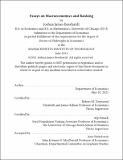Essays on Macroeconomics and Banking
Author(s)
Bosshardt, Joshua James
DownloadThesis PDF (1.255Mb)
Advisor
Townsend, Robert
Simsek, Alp
Terms of use
Metadata
Show full item recordAbstract
This thesis contains three papers related to measures for improving the stability of the banking system, including regulations and public ownership.
The first chapter shows using a difference-in-differences strategy that the introduction of the U.S. bank stress tests led small businesses to concentrate their debt within a smaller number of banks. I explain this using a model of bank competition in which creditworthy but informationally opaque firms have an incentive to establish a small number of concentrated lending relationships to facilitate information acquisition by their lenders. Tightening credit standards reduces the rate of non-performing loans, but it also decreases the availability of credit. In response, firms strengthen their lending relationships by concentrating in a smaller number of lenders. When the model is calibrated to match the empirical estimates, tightening credit standards has zero net effect on efficiency, but it shifts the surplus from firms to banks because firms have fewer informed lenders with which to bargain over prices.
The second chapter, joint with Ali Kakhbod, illustrates channels by which regulations that require banks to hold liquid assets can either increase or decrease a bank’s incentive to take risk with its remaining ineligible assets. A greater capacity to respond to liquidity stress increases the potential profits a bank would put at stake by making risky investments, but it also mitigates the illiquidity disadvantages of holding risky assets. We do not find evidence that the reserve requirement or the liquidity coverage ratio significantly affected measures of risk-taking such as non-performing loan ratios or credit default swap spreads.
The third chapter, joint with Eugenio Cerutti, shows that state-owned or public banks lent relatively more than domestic private banks during the Global Financial Crisis (GFC). Using a novel bank-level dataset covering 25 emerging market economies, we provide evidence that this was because they pursued an objective of helping to stabilize the economy, rather than because they had superior fundamentals or access to public or depositors’ funding. Nonetheless, their countercyclical behavior seems unique to the GFC rather than a regular characteristic of public banks before and after the GFC.
JEL Codes: G21, G28, G01
Date issued
2021-06Department
Massachusetts Institute of Technology. Department of EconomicsPublisher
Massachusetts Institute of Technology